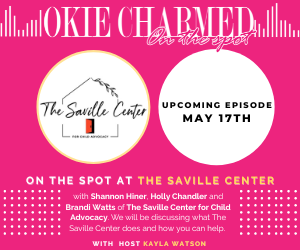The Saville Center
The red door that opens to The Saville Center in Stillwater, Ok intrigued me. I thought about the feelings the color red could symbolize. It can evoke feelings of excitement, strength, confi dence, or power. Red can also symbolize love or life.
I wasn’t able to think about what this red door could symbolize while I was there, but I do recall wanting to see what it would lead to. The moment I walked through that door, I was greeted with an environment meant to incite comfort and peace. Which, according to Kelsey Proctor, is the goal of the design and honestly I thought, “Wow, I wish I could make my own home feel this peaceful.”
I met with Kelsey Proctor, the executive director, and Holly Chandler, the forensic interviewer, of the Saville Center to learn a bit more about what they do for our community and more specifi cally, our children.
The Saville Center for Child Advocacy is a place where the Department of Human Services or law enforcement can refer children who have experienced abuse. Kelsey explained the confi dential nature of the cases they receive and how they are all under investigation.
In these cases, children oft en will have to visit with multiple people regarding the abuse they experienced. When they arrive at the Saville Center, they will fi rst meet Shannon Hiner. Shannon is the victims advocate and works with the family to be sure they have everything they need during this process. Next, the child and family will be introduced to Holly. Holly will then perform the forensic interview with the child. During which, Shannon is meeting with the family and detailing the process that they will experience.
“If the child discloses something in the forensic interview that warrants a medical exam, then that child meets Brandi,” Holly explained. Brandi Watts is the onsite clinical services director and performs the medical exam, if needed.
Children who come to the Saville Center for their services are always referred to counseling. At that point, the child would meet Mary Melton who is the onsite mental health therapist.
Now, the unique thing about the Saville Center is: rather than sending the child and their family to multiple locations in potentially diff erent towns to receive these services, all of these services are available in one place. The child does not receive all of these services at one time, but are able to come back to a familiar site with familiar faces to receive these services.
“We want it to be less traumatizing and the easiest possible way,” Kelsey said of the process of helping a child who lives in the area that the Saville Center serves. “Everything always circles back to that, you know, the child and keeping their best interests at heart.”
It only makes sense to have all of those services in one location and to help families feel more comfortable as they walk through an uncomfortable journey. But, all of this is a part of the Saville Center’s goal. According to their website, their mission is to “facilitate the protection, prevention, and healing of victims of child abuse and to promote the health of families in our community.”
With that goal in mind, they begin the healing process from the moment they walk in the door. Their facilities are comfortable, peaceful, and calming. The employees are kind, respectful, and compassionate. But, there is one very important employee that has not been mentioned, but I would assume the children would be most excited to meet her. That employee is Maria, their facility canine companion.
“She came from California from a specifi c place that trains and raises companion dogs, facility dogs, or therapy dogs,” Kelsey explained.
Holly jumped in about Maria saying, “She’s just incredible. She just has this sense and way about her. She knows when a kid needs her. We are so lucky to have her here.” Holly continued to tell me how Maria is now beingtrained to go into the forensic interviews with kids. She also is trained to be in the courtroom with kids.
Kelsey Proctor shared with me that the Saville Center is a non-profi t organization. Kelsey outlined where the funds to keep the Saville Center running comes from. There are a few diff erent grants that make up a decent portion of their funding. Another contribution comes from being a United Way agency. Outside of those areas of funding though, any other funds they need come from fundraisers and community help.
Several years ago, Stillwater High School raised money for the Saville Center during their SMAC. SMAC stands for Stillwater Makes a Change and is a fundraiser done by the local high school. During that fundraiser, the school was able to raise over $100,000. Those funds helped to create a larger parking area for the center as well as bring the precious Maria home to Oklahoma.
Another group that blesses their organization is the OSU chapter of Alpha Omicron Pi. The Saville Center is one of the philanthropic projects for AOπ. The sorority comes to clean the facilities every Friday. Also, they help keep the gardens looking great. Each year, they host a fundraiser for the Saville Center called Sweets for Saville. Kelsey bragged on the girls of Alpha Omicron Pi saying, “They are so incredible. I cannot imagine it without them!”
Kelsey and Holly shared with me that due to the confi dential nature of their job that not many community members are able to come and volunteer in a way that one would think they could. Because of the confi dentiality of their jobs, the ladies at Saville carry the weight of these experiences alone.
“Working in this field, you hear a lot of terrible things. So, I think we all have a super close bond, way more than just as employees. We know way too much about each other. We pray together; we laugh together,” Holly said of the ladies she works with. “We’re all kind of, it sounds kind of cheesy, like a family.”
The bond between these ladies is inspiring especially considering the nature of their work. Even though the community cannot participate with those who come through the Saville Center, they can volunteer in other ways. There are always volunteer opportunities and many groups in the community take part in that. But there are even ways to give back and help them from home.
Holly suggested, “Look at our stuff on Facebook and social media, and share that awareness” Some community members who want to give back to the Saville Center will call and see if there is something they need like snacks. In order to bring a little more comfort to their lives, some have even done sewing projects for the children that might come through the center.
Kelsey also told me about their board of directors at the Saville Center. The board is made up of various community members. Kelsey informed me, “They volunteer their time to serve on our board, which is incredible. We have an amazing board.”
When we have a group of people working to keep our children safe and help them heal from the hurts they have experienced, we tend to want to help. All it takes is a bit of creativity to off er something that might be able to bring comfort or peace to the victims. As well as, it might bring a little joy to those who are working so hard to help others.
There is also one more extremely important way that we can give back to what they are doing: help protect the children in our lives. Holly and Kelsey both reiterated this statement during our conversation. “In all the bad, I think we do see the good. There are people that care, and there are people that want to do the right thing,” Holly mentioned. “If you see something, report it. If you think something’s not right, check it out. It’s more of an educational piece. A lot of people don’t think that physical or sexual abuse happens in our neighborhood or our community.”
“If you see something, say something. You can’t turn a blind eye,” Kelsey off ered on the same note.
I’m sure these ladies wish that no one ever needed their particular skills, especially children. But, I know that if you ever experience the services at the Saville Center, that you are in the best hands possible because they care. They are only trying to “protect, prevent, and heal.”
I now know what that red door symbolizes or rather, what I think it symbolizes aft er becoming acquainted with this place. That red door represents HEART. It takes a lot of heart to be able to work in a place like the Saville Center. It takes a lot of heart to be able to off er a place to heal like the Saville Center. These ladies are the real deal. They have big hearts fi lled with compassion for their clients and this community. They represent the heart of giving back.
If you are interested in learning more about the Saville Center, visit their website at www.thesavillecenter.org.
written by Sara Lane
photography by Kayla Watson
- Log in to post comments











